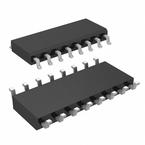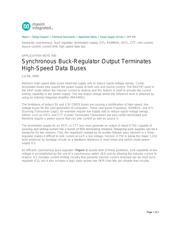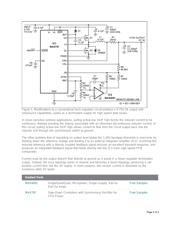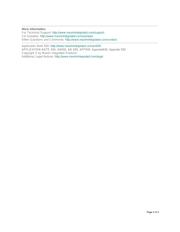下载

Maxim > Design Support > Technical Documents > Application Notes > Power-Supply Circuits > APP 930
Keywords: synchronous, buck regulator, termination supply, GTL, RAMBUS, HSTL, CTT, sink current,
source current, current limit, high speed data bus
APPLICATION NOTE 930
Synchronous Buck-Regulator Output Terminates
High-Speed Data Buses
Jul 09, 1998
Abstract: High-speed data buses need low supply rails to reduce signal-voltage swings. Center
terminated buses also require the power supply to both sink and source current. The MAX797 used in
the SKIP mode allows the inductor current to reverse and this feature is used to provide the current
sinking capability in the power supply. The low output voltage below the reference level is obtained by
using an external integrator amplifier (MAX4091).
The limitations of today's 5V and 3.3V CMOS buses are causing a proliferation of high-speed, low-
voltage buses for the next generation of computers. These new buses-Futurebus, RAMBUS, and GTL
(Gunning Transceiver Logic), for example-require low supply rails to reduce signal-voltage swings.
Others, such as HSTL and CTT (Center Terminated Transceiver) are also center-terminated and
therefore require a power source that can sink current as well as source it.
The termination supply for an HSTL or CTT bus must generate an output of about 0.75V, capable of
sourcing and sinking current into a bunch of 50Ω terminating resistors. Designing such supplies can be a
headache for two reasons. First, the headroom needed by an emitter-follower pass element in a linear
regulator makes it difficult to sink current at such a low voltage. Second, 0.75V is below the magic 1.25V
level produced by bandgap circuits as a feedback reference in most linear and switch-mode power-
supply ICs.
An efficient, synchronous buck regulator (Figure 1) avoids both of these problems. Sink capability at low
voltage is accomplished by the use of a synchronous switch (Q2) and by allowing the inductor current to
reverse. IC1 includes current-limiting circuitry that prevents inductor-current reversals (as do most buck-
regulator ICs), but it also includes a logic input (active-low SKIP) that lets you disable that circuitry.
Page 1 of 3





